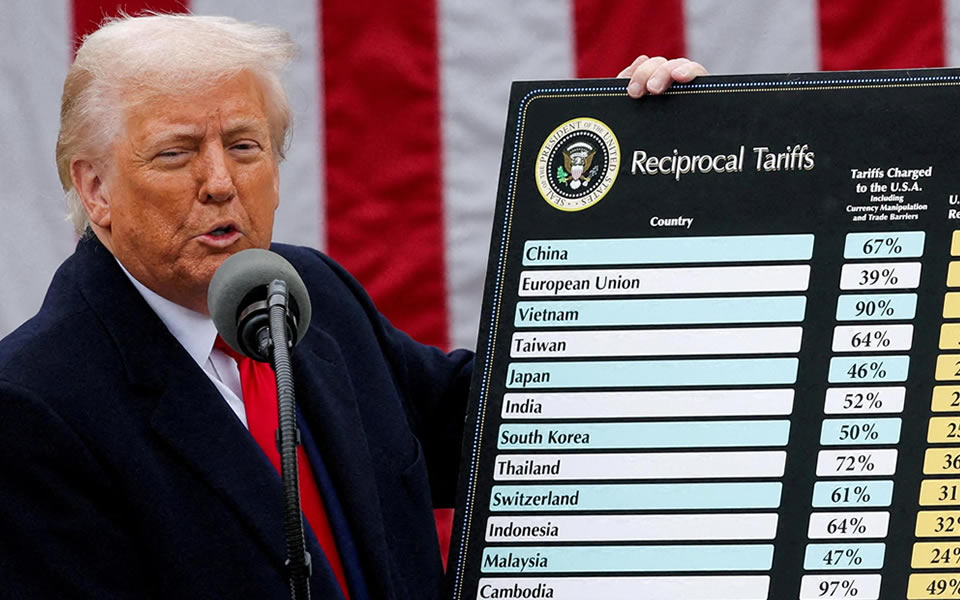
Extremism in the Sahel – Focus on JNIM
March 14, 2024
M23’s Advances & Security Dynamics in North Kivu
March 18, 2024SINKING SIGNALS: A LOOK AT WEST AFRICA’S DATA BLACKOUT
What You Should Know
- Widespread Impact of Cable Damage: The 2024 disruption to key subsea cables like ACE, MainOne, and WACS significantly impacted West and Central Africa, affecting not only internet users but also critical sectors such as finance, telecommunications, and government operations.
- Vital Role of Subsea Cables: These cables are crucial for high-speed data transmission and economic activities in Africa, providing a backbone for international connectivity and supporting various advanced services.
- Historical Vulnerability: Past incidents of cable damage have repeatedly highlighted the region's dependency on this infrastructure and the need for improved protection and rapid repair strategies.
- Urgent Need for Diversification: To reduce reliance on subsea cables, expansion of terrestrial fiber networks, investment in satellite communication, development of wireless broadband technologies, and promotion of public-private partnerships are imperative for building a more resilient digital infrastructure in West Africa.
Background
On 14th March 2024, the West and South Western coasts of Africa experienced a critical disruption in internet connectivity due to damage to several key subsea cables, including the Africa Coast to Europe (ACE), MainOne, and the West Africa Cable System (WACS). These cables, essential for high-speed data transmission across continents, significantly influence the region's economic, social, and governmental activities. The outage has affected multiple countries, highlighting the vulnerability of the region's digital infrastructure and the vital role these undersea cables play in maintaining connectivity in today's increasingly digital world. This report aims to provide an assessment of the incident, its impacts, and suggest measures to enhance the resilience of subsea cable networks in Africa.

Many people across West Africa have had major disruptions to their internet access due to widespread connectivity issues.
Current Situation Overview
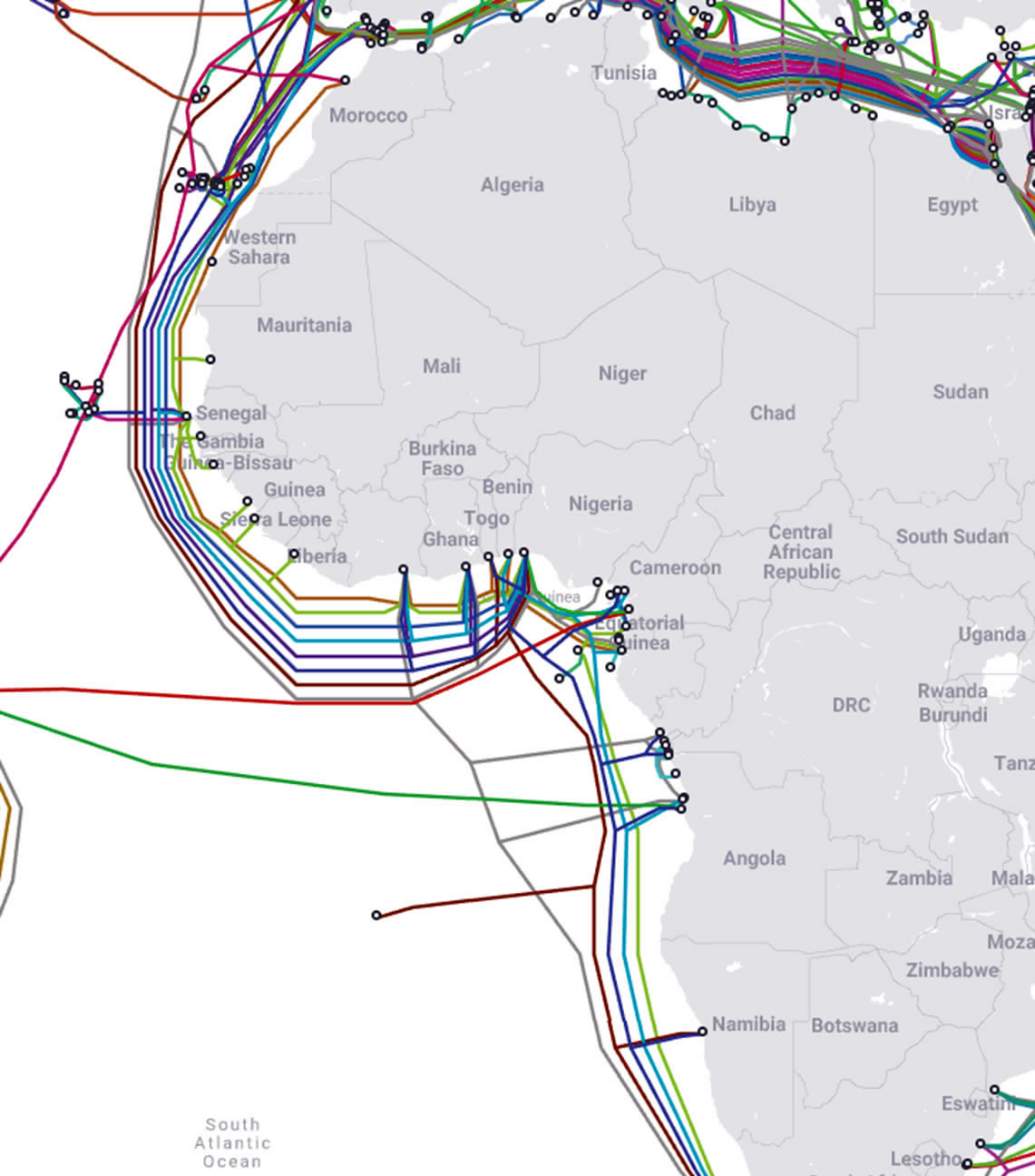
A map showing the sub-marine fibre optic cables along the Western coast of Africa. Source: www.submarinecablemap.com
The failure of several subsea cables, including the Africa Coast to Europe (ACE), MainOne, and the West Africa Cable System (WACS), resulted in a widespread internet outage across West and Central Africa. This event primarily affected countries such as Ivory Coast, Ghana, Nigeria, and Liberia. The outage is notable for its scope, impacting not just individual internet users but also key sectors including finance, telecommunications, and government operations.
The tangible effects of the outage are profound and multifaceted. Financial institutions faced disruptions in electronic transactions, leading to delays in international trade and local business operations. In the telecommunications sector, service providers reported significant challenges in data and voice communication, causing a sharp decline in service quality and availability. Government services, heavily reliant on online platforms, experienced interruptions, hindering public service delivery and administration. This incident highlights the fragility of the region's digital infrastructure and the crucial need for enhanced resilience and rapid response capabilities to mitigate such challenges in the future.
Importance of Subsea Cables
Subsea cables are a critical component of global communication infrastructure, often unnoticed yet vital for the digital era. These cables, laid deep on the ocean floor, form the backbone of international internet & telecom. The reliance on subsea cables is particularly significant for continents like Africa, where they are essential in connecting various countries to the rest of the world.
The primary function of subsea cables is to facilitate high-speed data transmission across continents. Unlike satellites, which can experience latency issues, subsea cables provide a more reliable and faster means of data transfer. This is crucial for activities such as international financial transactions, which require real-time processing capabilities. In Africa, where a significant portion of internet connectivity relies on mobile devices, these cables are even more critical. They enable not only basic communication but also support advanced services like cloud computing, online education, and telemedicine.
The strategic importance of these cables extends beyond connectivity; they are integral to economic growth and development. In a digital economy, international bandwidth provided by subsea cables directly influences the capability of countries to participate in global markets, attract foreign investment, and foster innovation. The disruption to these cables, therefore, not only impacts communication but can also have broader economic consequences, affecting trade, productivity, and the overall competitiveness of nations.
Timeline of Key Events
The recent subsea cable disruptions along the West and South Western coasts of Africa are not isolated incidents but part of a larger historical pattern of vulnerabilities in undersea communications infrastructure. Understanding the history of such outages provides context for the current situation and underscores the need for robust and resilient systems.
Over the years, several incidents have highlighted the fragility of subsea cables:
2023
The West African Cable System (WACS) and another cable, South Atlantic 3 (SAT-3), sustained damage near the mouth of the Congo River, leading to significant connectivity issues along the West African coast.2020
West Africa experienced internet disruptions attributed to faults in undersea cables, impacting countries like Nigeria and Ghana. MTN, a major telecom operator, specifically pointed to cable issues as the cause.2018
Damages to the African Coast to Europe (ACE) submarine cable resulted in a 48-hour complete internet blackout in 10 West African countries, demonstrating the region's heavy reliance on this key infrastructure.
These historical precedents reveal a pattern of vulnerability to physical damage, often caused by factors like ship anchors, fishing activities, or natural occurrences such as undersea landslides. Each incident has had a ripple effect, disrupting not just internet connectivity but also affecting economies and various sectors dependent on online services.
The consistent recurrence of these issues points to a need for enhanced measures in cable protection, maintenance, and rapid repair strategies. It also highlights the importance of investing in alternative technologies and infrastructure, such as additional cable routes or satellite communications, to provide redundancy and ensure continuity of service. The lessons learned from these historical events are crucial in shaping future strategies for safeguarding subsea cable infrastructure, which is a lifeline for modern digital communication and economic activities in Africa and beyond.
Existing Sub-Sea Infrastructure in West Africa
West Africa's sub-sea infrastructure comprises several crucial cables that form a network pivotal for the region's connectivity with the wider world. These cables are strategically laid out along the ocean floor, connecting various countries within Africa to each other and to other continents. The major sub-sea cables serving West Africa include:
- Africa Coast to Europe (ACE)
- West Africa Cable System (WACS)
- MainOne (Now an Equinix Company)
- SAT-3/WASC
- Glo-1
- Maroc Telecom West Africa
- Equiano (Google)
- 2Africa (Projected for 2024)

Launched in December 2012, this 17,000 km cable links Europe to the West Coast of Africa, with landing points in multiple countries including Cote d'Ivoire, Ghana, Nigeria, and Senegal. ACE plays a vital role in the digital economy of these nations by providing high-capacity and high-speed international bandwidth.

Operational since May 2012, WACS is a 14,530 km cable stretching from South Africa to the United Kingdom, passing through many West African countries. It serves as a significant conduit for international traffic from the region.
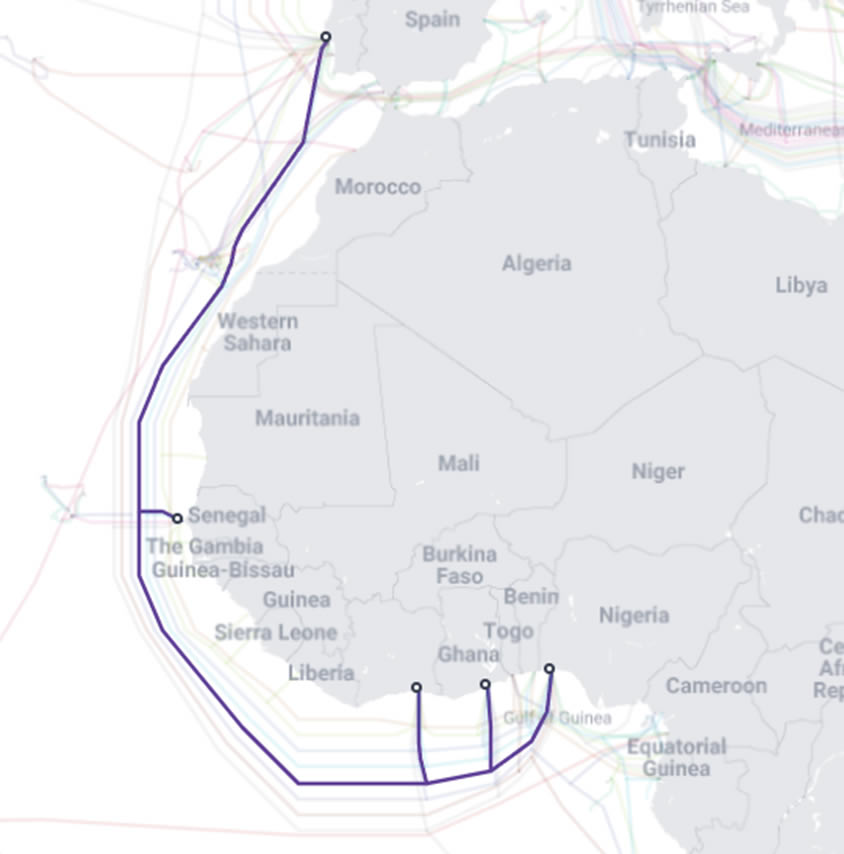
MainOne, launched in July 2010, spans 7,000 km and connects West Africa, particularly Nigeria and Ghana, to Europe. It has been instrumental in boosting broadband penetration in the region.
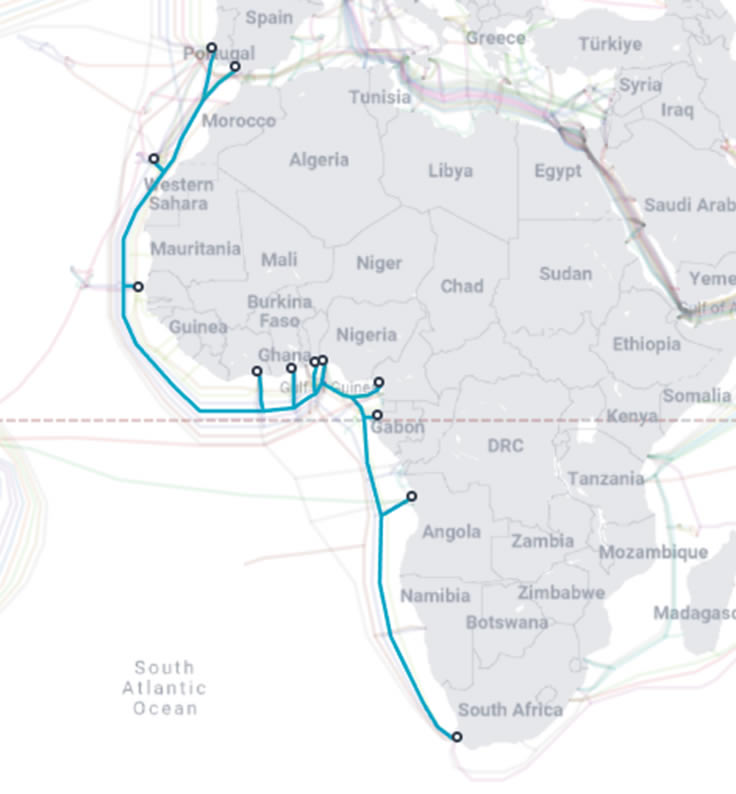
SAT-3/WASC, which became operational in April 2002, covers 14,350 km, connecting Portugal and Spain to South Africa, with several landing points along the West African coast. It was one of the earliest cables to provide substantial internet capacity to the region.
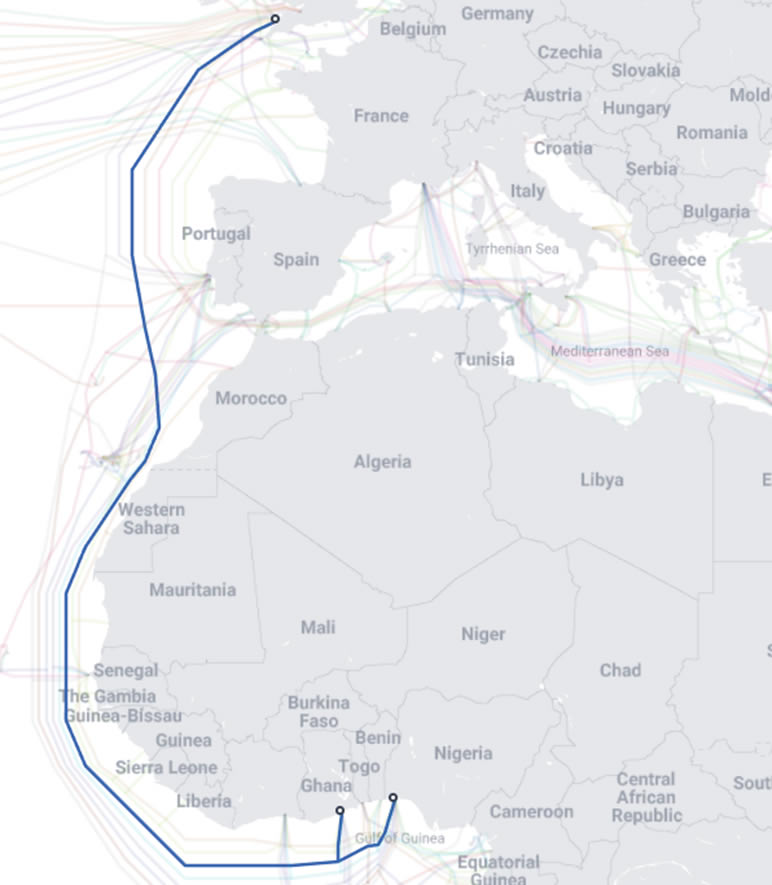
Owned by Nigeria's Globacom Limited, Glo-1, inaugurated in October 2010, is a 9,800 km cable that connects West Africa, mainly Ghana and Nigeria, to the United Kingdom. It is significant for enhancing telecoms and broadband services in these countries.
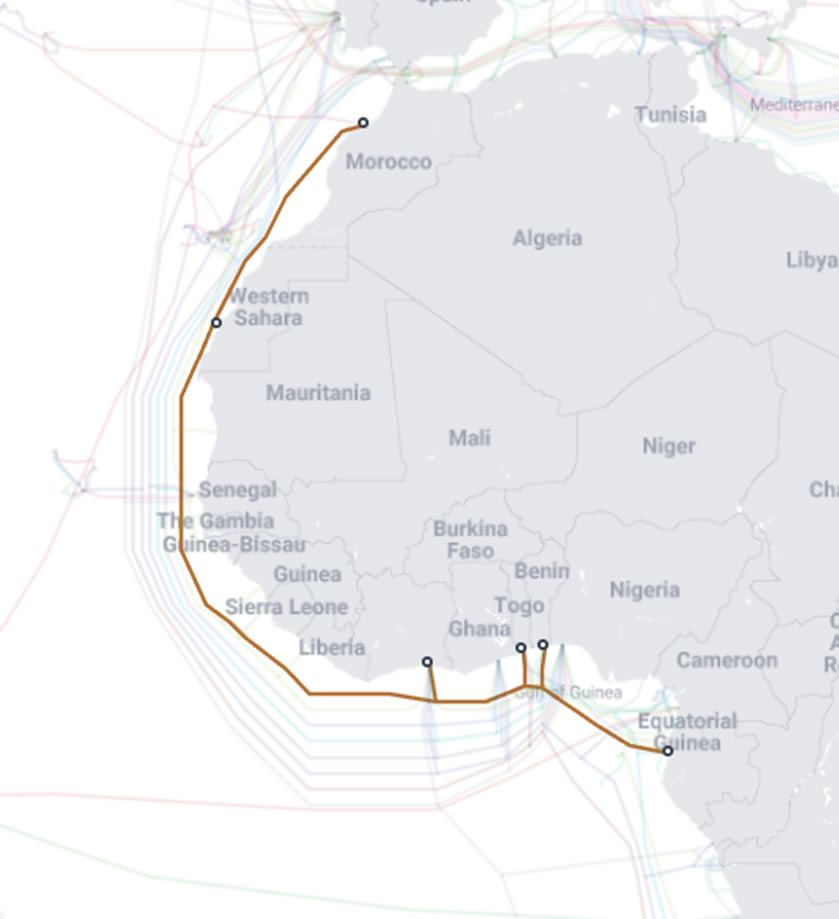
Operational since July 2021, this 8,600 km cable extends from Morocco down to Togo, with key landing points in Benin, Côte d'Ivoire, Gabon, and Morocco. This cable enhances the region's connectivity, offering an alternative route for data transmission and reinforcing the network against potential disruptions.
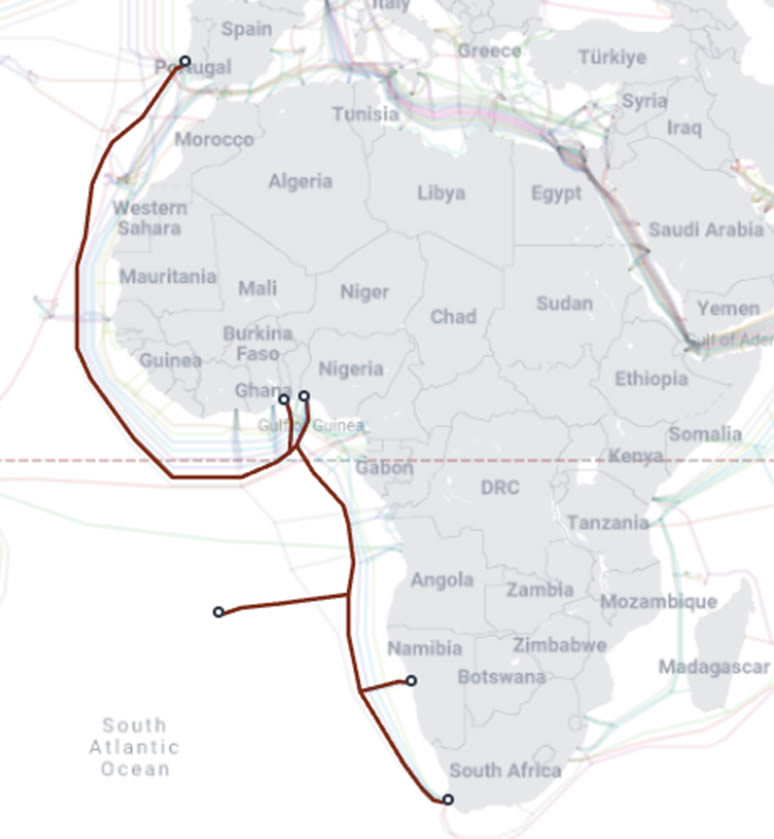
Starting operations in February 2023, this 15,000 km cable runs from Portugal down to South Africa, with a branch to Nigeria. Funded by Google, Equiano is notable for its cutting-edge technology offering high capacity and low-latency internet access.

Envisioned to be one of the world's largest subsea cable projects, spanning 45,000 km, 2Africa aims to connect Africa with Europe and the Middle East, further enhancing connectivity for the continent.

Internet Service Providers (ISP) have been working to re-route their networks, especially for clients running critical system and infrastrucutre.
A Need for Diversification
The resilience of West Africa’s internet connectivity infrastructure can be significantly enhanced through diversification. Reducing dependency on undersea cables and incorporating a variety of connectivity methods is crucial in building a robust digital infrastructure.
By incorporating the following diversification approaches, West African countries can create more resilient and adaptable internet infrastructure, capable of withstanding disruptions and catering to the growing digital needs of the region.
Expanding Terrestrial Fiber Networks
Terrestrial fiber optic networks are a vital complementary infrastructure to subsea cables. Their expansion across the continent, especially into landlocked and remote areas, can provide stable and high-speed internet access. This infrastructure is particularly beneficial for intra-continental communication and can serve as a reliable alternative during subsea cable outages.
Investment in Satellite Communication
Satellite technology, including emerging Low-Earth Orbit (LEO) satellites, offers a promising solution for regions with limited subsea cable access. This technology can provide widespread coverage, reaching remote and rural areas where laying fiber optic cables is challenging. Satellite internet also serves as a valuable backup, ensuring connectivity during disruptions in terrestrial and subsea networks.
Development of Wireless Broadband Technologies
Wireless technologies, such as 4G and 5G networks, offer another avenue for diversifying internet access. These technologies can supplement fixed broadband, particularly in areas where cable deployment is impractical. They also provide the flexibility and scalability needed to meet the rapidly growing demand for internet access in urban and high-density areas.
Promotion of Public-Private Partnerships (PPP)
Encouraging collaborations between governments and private entities is essential for the successful implementation of a diversified connectivity infrastructure. Such partnerships can facilitate the investment, innovation, and expertise needed to develop and maintain various internet access methods.
Conclusion
The extensive disruptions to West Africa's subsea cable infrastructure serve as a critical wake-up call to the region's reliance on underwater cables for internet connectivity. The incidents highlight not only the vulnerabilities inherent in such a centralized system but also the urgent need to diversify and strengthen the digital infrastructure. As the region advances, the adoption of a multifaceted approach involving terrestrial fiber expansions, satellite communication enhancements, and the development of wireless broadband technologies becomes imperative. Embracing these alternatives, supported by robust public-private partnerships and forward-thinking policies, will be key to ensuring a resilient, stable, and inclusive digital future for West Africa, safeguarding against potential disruptions and fostering sustainable socio-economic growth.



